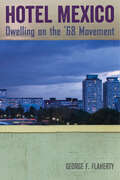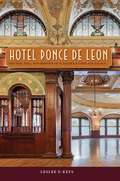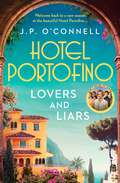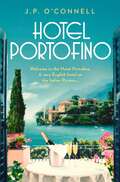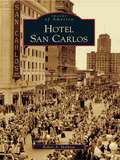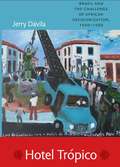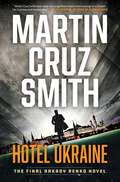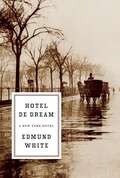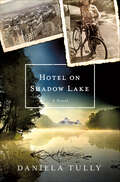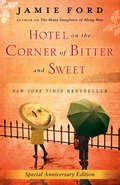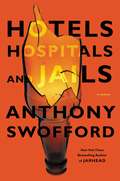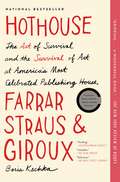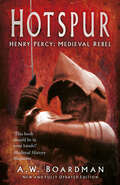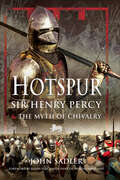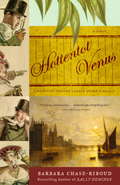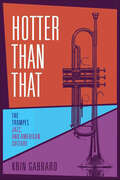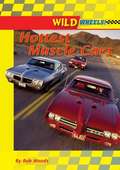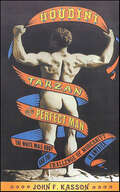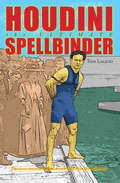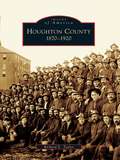- Table View
- List View
Hotel Mexico: Dwelling on the '68 Movement
by George F. FlahertyIn 1968, Mexico prepared to host the Olympic games amid growing civil unrest. The spectacular sports facilities and urban redevelopment projects built by the government in Mexico City mirrored the country's rapid but uneven modernization. In the same year, a street-savvy democratization movement led by students emerged in the city. Throughout the summer, the '68 Movement staged protests underscoring a widespread sense of political disenfranchisement. Just ten days before the Olympics began, nearly three hundred student protestors were massacred by the military in a plaza at the core of a new public housing complex. In spite of institutional denial and censorship, the 1968 massacre remains a touchstone in contemporary Mexican culture thanks to the public memory work of survivors and Mexico's leftist intelligentsia. In this highly original study of the afterlives of the '68 Movement, George F. Flaherty explores how urban spaces--material but also literary, photographic, and cinematic--became an archive of 1968, providing a framework for de facto modes of justice for years to come.
Hotel Mexico: Dwelling on the '68 Movement
by George F. FlahertyIn 1968, Mexico prepared to host the Olympic games amid growing civil unrest. The spectacular sports facilities and urban redevelopment projects built by the government in Mexico City mirrored the country’s rapid but uneven modernization. In the same year, a street-savvy democratization movement led by students emerged in the city. Throughout the summer, the ‘68 Movement staged protests underscoring a widespread sense of political disenfranchisement. Just ten days before the Olympics began, nearly three hundred student protestors were massacred by the military in a plaza at the core of a new public housing complex. In spite of institutional denial and censorship, the 1968 massacre remains a touchstone in contemporary Mexican culture thanks to the public memory work of survivors and Mexico’s leftist intelligentsia. In this highly original study of the afterlives of the ’68 Movement, George F. Flaherty explores how urban spaces—material but also literary, photographic, and cinematic—became an archive of 1968, providing a framework for de facto modes of justice for years to come.
Hotel Ponce de Leon: The Rise, Fall, and Rebirth of Flagler's Gilded Age Palace
by Leslee F. KeysHistoric St. Augustine Research Institute William L. Proctor Award Henry Flagler's opulent Hotel Ponce de Leon drew worldwide praise from the day its elaborately carved doors opened in 1888. Built in the Spanish Renaissance Revival style, the architectural and engineering marvel featured the talents of a team of renowned artisans, including the designs of architects John Carrère, Thomas Hastings, and Bernard Maybeck, electricity by Thomas Edison, and interior decoration and stained glass windows by Louis Tiffany. Hotel Ponce de Leon is the first work to present the building's complete history and detail its transformation into the heart of Flagler College. Leslee Keys, who assisted in the restoration, recounts the complicated construction of the hotel--the first major structure to be built entirely of poured concrete--and the efforts to preserve it and restore it to its former glory. The methods used at Flagler College have been recognized as best practices in historic preservation and decorative arts conservation, and today the campus is one of Florida's most visited heritage tourism destinations.
Hotel Portofino: A MAJOR ITV DRAMA
by J. P O’ConnellRomance, intrigue, and dangerous ambitions combine to create the perfect escape: welcome to the beautiful Hotel Portofino on the magical Italian Riviera. ***NOW A MAJOR TV DRAMA*** It is the summer of 1927 and Hotel Portofino is prospering under Bella&’s stewardship. As the season begins, Bella is keenly looking forward to her son Lucian&’s imminent arrival and the chance to discuss with him her plans to convert the hotel&’s basement into a spa. But then Bella&’s husband Cecil turns up unannounced, Over the course of several hot weeks in the middle of the Italian summer, Bella is forced to confront the reality of her relationship with Cecil and to decide to what extent she is prepared to go against social convention to get what she wants. As she welcomes her guests, old and new, an anonymous visit from a travel guide inspector threatens to make or break the hotel&’s future.Enjoy a new season at Hotel Portofino, a heady historical drama set during the 1920s. Perfect for fans of Downton Abbey and The Durrells.
Hotel Portofino: NOW A MAJOR ITV DRAMA
by J. P O’ConnellRomance, intrigue, and dangerous ambitions combine to create the perfect escape: welcome back to the beautiful Hotel Portofino on the magical Italian Riviera. HOTEL PORTOFINO: LOVERS AND LIARS IS OUT NOW! ***NOW A MAJOR ITV DRAMA*** A heady historical drama about a British family who open an upper-class hotel on the magical Italian Riviera during the &‘Roaring 20s&’. Hotel Portofino has been open for only a few weeks, but already the problems are mounting for its owner Bella Ainsworth. Her high-class guests are demanding and hard to please. And she&’s being targeted by a scheming and corrupt local politician, who threatens to drag her into the red-hot cauldron of Mussolini&’s Italy. To make matters worse, her marriage is in trouble, and her children are still struggling to recover from the repercussions of the Great War. All eyes are on the arrival of a potential love match for her son Lucian, but events don&’t go to plan, which will have far reaching consequences for the whole family. Set in the breathtakingly beautiful Italian Riviera, Hotel Portofino is a story of personal awakening at a time of global upheaval and of the liberating influence of Italy&’s enchanting culture, climate and cuisine on British &‘innocents abroad&’, perfect for fans of Downton Abbey and The Crown.
Hotel San Carlos
by Robert A. MelikianOn the corner of Central Avenue and Monroe Street, in the center of downtown Phoenix, is the historic Hotel San Carlos. Local Native Americans once worshipped a god of learning in this same area, and so early white settlers chose the site for the city's first school, the Little Adobe School, in 1873. After the Little Adobe School, the location served as a ballpark, a brick schoolhouse, the Central School, and finally the Hotel San Carlos, which opened in March 1928. The first hotel in Phoenix to boast steam heat, elevators, and air-conditioning, Hotel San Carlos has a remarkable story and has even seen its share of movie stars, including Mae West, Gene Autry, and Marilyn Monroe. Clark Gable always stayed in the same corner room on the fourth floor so he could people-watch. Even the friendly ghost of Leone Jensen, who appears regularly at the foot of the guest beds, has added to the unique legacy and continuing popularity of Hotel San Carlos.
Hotel Scarface: Where Cocaine Cowboys Partied and Plotted to Control Miami
by Roben FarzadThe wild, true story of the Mutiny, the hotel and club that embodied the decadence of Miami’s cocaine cowboys heyday—and an inspiration for the blockbuster film, Scarface...In the seventies, coke hit Miami with the full force of a hurricane, and no place attracted dealers and dopers like Coconut Grove’s Mutiny at Sailboat Bay. Hollywood royalty, rock stars, and models flocked to the hotel’s club to order bottle after bottle of Dom and to snort lines alongside narcos, hit men, and gunrunners, all while marathon orgies burned upstairs in elaborate fantasy suites. Amid the boatloads of powder and cash reigned the new kings of Miami: three waves of Cuban immigrants vying to dominate the trafficking of one of the most lucrative commodities ever known to man. But as the kilos—and bodies—began to pile up, the Mutiny became target number one for law enforcement. Based on exclusive interviews and never-before-seen documents, Hotel Scarface is a portrait of a city high on excess and greed, an extraordinary work of investigative journalism offering an unprecedented view of the rise and fall of cocaine—and the Mutiny—in Miami.
Hotel Trópico: Brazil and the Challenge of African Decolonization, 1950-1980
by Jerry DávilaIn the wake of African decolonization, Brazil attempted to forge connections with newly independent countries. In the early 1960s it launched an effort to establish diplomatic ties with Africa; in the 1970s it undertook trade campaigns to open African markets to Brazilian technology. Hotel Trpico reveals the perceptions, particularly regarding race, of the diplomats and intellectuals who traveled to Africa on Brazil's behalf. Jerry Dvila analyzes how their actions were shaped by ideas of Brazil as an emerging world power, ready to expand its sphere of influence; of Africa as the natural place to assert that influence, given its historical slave-trade ties to Brazil; and of twentieth-century Brazil as a "racial democracy," a uniquely harmonious mix of races and cultures. While the experiences of Brazilian policymakers and diplomats in Africa reflected the logic of racial democracy, they also exposed ruptures in this interpretation of Brazilian identity. Did Brazil share a "lusotropical" identity with Portugal and its African colonies, so that it was bound to support Portuguese colonialism at the expense of Brazil's ties with African nations? Or was Brazil a country of "Africans of every color," compelled to support decolonization in its role as a natural leader in the South Atlantic? Drawing on interviews with retired Brazilian diplomats and intellectuals, Dvila shows the Brazilian belief in racial democracy to be about not only race but also Portuguese ethnicity.
Hotel Ukraine: The Final Arkady Renko Novel (The Arkady Renko Novels)
by Martin Cruz SmithDetective Arkady Renko—&“one of the most compelling figures in modern fiction&” (USA TODAY)—returns in this tense thriller set amid the backdrop of Russia&’s invasion of Ukraine.In the latest installment of Martin Cruz Smith&’s celebrated Arkady Renko series, the legendary Moscow investigator seeks to solve the murder of a diplomat as Russia&’s invasion of Ukraine wears on and the effects of Renko&’s Parkinson&’s Disease worsen. Helped by his lover, journalist Tatiana Petrovna, Renko traces the murder to a Russian paramilitary group aided by a government official who also used to be a romantic partner of Renko. Before long, those responsible for the killing look to similarly dispatch Arkady and Tatiana—all of it leading to a thrilling and action-packed climax. Hotel Ukraine upholds Martin Cruz Smith&’s reputation as a master of modern detective fiction and Arkady Renko&’s standing as one of the genre&’s most complex protagonists.
Hotel de Dream: A New York Novel
by Edmund WhiteIn a damp, old Sussex castle, American literary phenomenon Stephen Crane lies on his deathbed, wasting away from tuberculosis at the age of twenty-eight. The world-famous author has retreated to England with his wife, Cora, in part to avoid gossip about her ignominious past as the proprietress of an infamous Florida bordello, the Hotel de Dream. In the midst of gathering tragedy, Crane begins dictating what will surely be his final work: a strange and poignant novel of a boy prostitute in 1890s New York and the married man who ruins his own life to win his love.
Hotel on Shadow Lake: A Novel
by Daniela TullySuspenseful and compelling, Daniela Tully’s Hotel on Shadow Lake is at once an intricate mystery, an epic romance, and a Gothic family saga.When Maya was a girl in Germany, her grandmother was everything to her: teller of magical fairy tales, surrogate mother, best friend. Then, shortly after Maya’s sixteenth birthday, her grandmother disappeared without a trace, leaving Maya with only questions to fill the void. Twenty-seven years later, her grandmother’s body is found in a place she had no connection to: the Montgomery Resort in upstate New York. How did she get there? Why had she come? Desperate for answers, Maya leaves her life in Germany behind and travels to America, where she is drawn to the powerful family that owns the hotel and seemingly the rest of the town. Soon Maya is unraveling secrets that go back decades, from 1910s New York to 1930s Germany and beyond. But when she begins to find herself spinning her own lies in order to uncover the circumstances surrounding her grandmother’s death, she must decide whether her life and a chance at true love are worth risking for the truth.
Hotel on the Corner of Bitter and Sweet and Songs of Willow Frost: Two Bestselling Novels
by Jamie FordJamie Ford caused a stir among readers with his unforgettable debut, Hotel on the Corner of Bitter and Sweet, which he followed up with the much-anticipated Songs of Willow Frost. Each in their own way, these New York Times bestsellers delve into the past, combining exquisite storytelling with heartfelt explorations of family, love, and heritage. Now both magnificent novels are together in one exclusive eBook bundle. HOTEL ON THE CORNER OF BITTER AND SWEET "Mesmerizing and evocative . . . a tale of conflicted loyalties and timeless devotion."--Sara Gruen, author of Water for Elephants "A wartime-era Chinese-Japanese variation on Romeo and Juliet . . . The period detail [is] so revealing and so well rendered."--The Seattle Times In 1986, Henry Lee joins a crowd outside the Panama Hotel, once the gateway to Seattle's Japantown, where the new owner has discovered the belongings of Japanese families who were sent to internment camps during World War II. As the owner displays and unfurls a Japanese parasol, Henry, a Chinese American, remembers a young Japanese American girl from his childhood in the 1940s--Keiko Okabe, with whom he forged a bond that transcended the prejudices of their Old World ancestors. After Keiko and her family were evacuated, she and Henry could only hope that their promise to each other would be kept. Now, forty years later, Henry explores the hotel's basement for the Okabe family's belongings and for a long-lost object whose value he cannot even begin to measure. SONGS OF WILLOW FROST "Jamie Ford is a first-rate novelist, and with Songs of Willow Frost he takes a great leap forward and demonstrates the uncanny ability to move me to tears."--Pat Conroy, author of The Prince of Tides "Arresting . . . [with] the kind of ending readers always hope for, but seldom get."--The Dallas Morning News Seattle, 1934: Twelve-year-old William Eng, a Chinese American boy, has lived at Sacred Heart Orphanage ever since his mother was carried away from their small apartment five years ago. But now William, in a rare visit to the movies, has glimpsed an actress on the silver screen who goes by the name of Willow Frost. Struck by her features, William is convinced that she is his mother. Determined to find her, William escapes from Sacred Heart with his friend Charlotte. The pair navigate the streets of Seattle, where they must not only survive but confront the mysteries of William's past and his connection to Willow Frost . . . a woman whose story is far more complicated than any fantasy portrayed onscreen.
Hotel on the Corner of Bitter and Sweet: A Novel
by Jamie FordBONUS: This edition contains a Hotel on the Corner of Bitter and Sweet discussion guide. "Sentimental, heartfelt....the exploration of Henry's changing relationship with his family and with Keiko will keep most readers turning pages...A timely debut that not only reminds readers of a shameful episode in American history, but cautions us to examine the present and take heed we don't repeat those injustices."-- Kirkus Reviews "A tender and satisfying novel set in a time and a place lost forever, Hotel on the Corner of Bitter and Sweet gives us a glimpse of the damage that is caused by war--not the sweeping damage of the battlefield, but the cold, cruel damage to the hearts and humanity of individual people. Especially relevant in today's world, this is a beautifully written book that will make you think. And, more importantly, it will make you feel." -- Garth Stein, New York Times bestselling author of The Art of Racing in the Rain "Jamie Ford's first novel explores the age-old conflicts between father and son, the beauty and sadness of what happened to Japanese Americans in the Seattle area during World War II, and the depths and longing of deep-heart love. An impressive, bitter, and sweet debut." -- Lisa See, bestselling author of Snow Flower and the Secret Fan In the opening pages of Jamie Ford's stunning debut novel, Hotel on the Corner of Bitter and Sweet, Henry Lee comes upon a crowd gathered outside the Panama Hotel, once the gateway to Seattle's Japantown. It has been boarded up for decades, but now the new owner has made an incredible discovery: the belongings of Japanese families, left when they were rounded up and sent to internment camps during World War II. As Henry looks on, the owner opens a Japanese parasol. This simple act takes old Henry Lee back to the 1940s, at the height of the war, when young Henry's world is a jumble of confusion and excitement, and to his father, who is obsessed with the war in China and having Henry grow up American. While "scholarshipping" at the exclusive Rainier Elementary, where the white kids ignore him, Henry meets Keiko Okabe, a young Japanese American student. Amid the chaos of blackouts, curfews, and FBI raids, Henry and Keiko forge a bond of friendship-and innocent love-that transcends the long-standing prejudices of their Old World ancestors. And after Keiko and her family are swept up in the evacuations to the internment camps, she and Henry are left only with the hope that the war will end, and that their promise to each other will be kept. Forty years later, Henry Lee is certain that the parasol belonged to Keiko. In the hotel's dark dusty basement he begins looking for signs of the Okabe family's belongings and for a long-lost object whose value he cannot begin to measure. Now a widower, Henry is still trying to find his voice-words that might explain the actions of his nationalistic father; words that might bridge the gap between him and his modern, Chinese American son; words that might help him confront the choices he made many years ago. Set during one of the most conflicted and volatile times in American history, Hotel on the Corner of Bitter and Sweet is an extraordinary story of commitment and enduring hope. In Henry and Keiko, Jamie Ford has created an unforgettable duo whose story teaches us of the power of forgiveness and the human heart.
Hotels (Cutaways)
by Jules O'DwyerFrom Marienbad to the Bates Motel, cinematic hotels are more than a mere backdrop to a film’s action. They actively scaffold the formal, aesthetic, and narrative possibilities of cinema. This book takes a journey through spaces of temporary dwelling—hotels, inns, and motels—to delve into the dynamics and contradictions that structure modern life.Along the way, O’Dwyer considers questions of plot and eroticism, labor and globalization, and the ethics and economics of hospitality. Drawing on a broad array of films from European art cinema to experimental adult media, and placing cinema into dialogue with film theory and media history, Hotels explores both how and why the hotel has such a strong purchase on the cinematic imaginary.
Hotels and Highways: The Construction of Modernization Theory in Cold War Turkey (Stanford Studies in Middle Eastern and Islamic Societies and Cultures)
by Begüm AdaletThe early decades of the Cold War presented seemingly boundless opportunity for the construction of "laboratories" of American society abroad: microcosms where experts could scale down problems of geopolitics to manageable size, and where locals could be systematically directed toward American visions of capitalist modernity. Among the most critical tools in the U.S.'s ideological arsenal was modernization theory, and Turkey emerged as a vital test case for the construction and validation of developmental thought and practice. With this book, Begüm Adalet reveals how Turkey became both the archetypal model of modernization and an active partner for its enactment. Through her analysis of the flow of aid money and expertise between the U.S. and Turkey, the planning of the American-funded Turkish highway network, and the development of the Turkish tourism industry, Adalet also highlights how "problems of knowledge" are fundamentally entwined with "problems of the political order": social scientific theories are produced in material spaces, through uncertain encounters between transnational actors and policy networks. In tracking the growth and transmission of modernization as a theory and in practice in Turkey, Hotels and Highways offers not only a specific history of a postwar development model that continues to influence our world, but a widely relevant consideration of how theoretical debates take shape in concrete situations.
Hotels, Hospitals, and Jails: A Memoir
by Anthony SwoffordThe publication of Jarhead launched a new career for Anthony Swofford, earning him accolades for its gritty and unexpected portraits of the soldiers who fought in the Gulf War. It spawned a Hollywood movie. It made Swofford famous and wealthy. It also nearly killed him. Now with the same unremitting intensity he brought to his first memoir, Swofford describes his search for identity, meaning, and a reconciliation with his dying father in the years after he returned from serving as a sniper in the Marines. Adjusting to life after war, he watched his older brother succumb to cancer and his first marriage crumble, leading him to pursue an excessive lifestyle in Manhattan that brought him to the brink of collapse. Consumed by drugs, drinking, expensive cars, and women, Swofford lost almost everything and everyone that mattered to him. When a son is in trouble he hopes to turn to his greatest source of wisdom and support: his father. But Swofford and his father didn't exactly have that kind of relationship. The key, he realized, was to confront the man-a philandering, once hard-drinking, now terminally ill Vietnam vet he had struggled hard to understand and even harder to love. The two stubborn, strong-willed war vets embarked on a series of RV trips that quickly became a kind of reckoning in which Swofford took his father to task for a lifetime of infidelities and abuse. For many years Swofford had considered combat the decisive test of a man's greatness. With the understanding that came from these trips and the fateful encounter that took him to a like-minded woman named Christa, Swofford began to understand that becoming a father himself might be the ultimate measure of his life. Elegantly weaving his family's past with his own present-nights of excess and sexual conquest, visits with injured war veterans, and a near-fatal car crash--Swofford casts a courageous, insistent eye on both his father and himself in order to make sense of what his military service meant, and to decide, after nearly ending it, what his life can and should become as a man, a veteran, and a father.
Hothouse: The Art of Survival and the Survival of Art at America's Most Celebrated Publishing House, Farrar, Straus, and Giroux
by Boris Kachka"Mad Men for the literary world." --Junot DíazFarrar, Straus and Giroux is arguably the most influential publishing house of the modern era. Home to an unrivaled twenty-five Nobel Prize winners and generation-defining authors like T. S. Eliot, Flannery O'Connor, Susan Sontag, Tom Wolfe, Joan Didion, Philip Roth, and Jonathan Franzen, it's a cultural institution whose importance approaches that of The New Yorker or The New York Times. But FSG is no ivory tower--the owner's wife called the office a "sexual sewer"--and its untold story is as tumultuous and engrossing as many of the great novels it has published. Boris Kachka deftly reveals the era and the city that built FSG through the stories of two men: founder-owner Roger Straus, the pugnacious black sheep of his powerful German-Jewish family--with his bottomless supply of ascots, charm, and vulgarity of every stripe--and his utter opposite, the reticent, closeted editor Robert Giroux, who rose from working-class New Jersey to discover the novelists and poets who helped define American culture. Giroux became one of T. S. Eliot's best friends, just missed out on The Catcher in the Rye, and played the placid caretaker to manic-depressive geniuses like Robert Lowell, John Berryman, Jean Stafford, and Jack Kerouac. Straus, the brilliant showman, made Susan Sontag a star, kept Edmund Wilson out of prison, and turned Isaac Bashevis Singer from a Yiddish scribbler into a Nobelist--even as he spread the gossip on which literary New York thrived. A prolific lover and an epic fighter, Straus ventured fearlessly, and sometimes recklessly, into battle for his books, his authors, and his often-struggling company. When a talented editor left for more money and threatened to take all his writers, Roger roared, "Over my dead body"--and meant it. He turned a philosophical disagreement with Simon & Schuster head Dick Snyder into a mano a mano media war that caught writers such as Philip Roth and Joan Didion in the crossfire. He fought off would-be buyers like S. I. Newhouse ("that dwarf") with one hand and rapacious literary agents like Andrew Wylie ("that shit") with the other. Even his own son and presumed successor was no match for a man who had to win at any cost--and who was proven right at almost every turn. At the center of the story, always, are the writers themselves. After giving us a fresh perspective on the postwar authors we thought we knew, Kachka pulls back the curtain to expose how elite publishing works today. He gets inside the editorial meetings where writers' fates are decided; he captures the adrenaline rush of bidding wars for top talent; and he lifts the lid on the high-stakes pursuit of that rarest commodity, public attention--including a fly-on-the-wall account of the explosive confrontation between Oprah Winfrey and Jonathan Franzen, whose relationship, Franzen tells us, "was bogus from the start." Vast but detailed, full of both fresh gossip and keen insight into how the literary world works, Hothouse is the product of five years of research and nearly two hundred interviews by a veteran New York magazine writer. It tells an essential story for the first time, providing a delicious inside perspective on the rich pageant of postwar cultural life and illuminating the vital intellectual center of the American Century.
Hotspur: Henry Percy: Medieval Rebel
by Andrew Boardman‘This book should be in your hands!’ – Medieval History Magazine'A detailed and readable account of Hotspur’s life that conveys a sense of the endemic violence of the Border Marches.’ – Northern History‘Boardman has studied the battlefields of Otterburn, Homildon Hill and Shrewsbury and combines knowledge of terrain, weapons, and tactics with contemporary narratives to produce feasible reconstructions and explanations of what actually occurred.’ – Michael HicksImmortalised by Shakespeare in Henry IV, Part I, Henry Percy, nicknamed ‘Hotspur’, is among the best known of all his warlike characters.As the young, honourablebut impatient rebel soldier whose chivalrous exploits on the battlefield end in disaster at Shrewsbury in 1403, Hotspur is the archetypal anti-hero: a character of such tragic and dramatic significance that even his well-known nickname has passed from history into legend. But who was the historical Henry Percy, and why did his rise to fame bring him into direct confrontation with his king?This fully updated book tells the story of the real Henry Percy and his overbearing family, and how the survival of a great northern dynasty led to open rebellion and ultimately military failure.
Hotspur: Sir Henry Percy & the Myth of Chivalry
by John SadlerOn 21 July 1403 Sir Henry Percy – better known as Hotspur – led a rebel army out at Shrewsbury to face the forces of the king Henry IV. The battle was both bloody and decisive. Hotspur was shot down by an arrow and killed. Posthumously he was declared a traitor and his lands forfeited to the crown. This was an ignominious end to the brilliant career of one of the most famous medieval noblemen, a remarkable soldier, diplomat and courtier who played a leading role in the reigns of Richard II and Henry IV. How did he earn his extraordinary reputation, and why did Shakespeare portray him as a fearsomely brave but flawed hero who, despite a traitor’s death, remained the mirror of chivalry? These are questions John Sadler seeks to answer in the first full biography of this legendary figure to be published for over twenty years. Hotspur’s exploits as a soldier in France during the Hundred Years War, against the Scots in the Scottish borders and at the battles of Otterburn, Homildon Hill and Shrewsbury have overshadowed his diplomatic role as a loyal royal servant in missions to Prussia, Cyprus, Ireland and Aquitaine. And, as the heir to one of the foremost noble families of northern England, he was an important player not only in the affairs of the North but of the kingdom as a whole. So, as John Sadler reveals in this highly readable study, Hotspur was a much more varied and interesting character than his narrow reputation for headstrong attack and rebellion suggests.
Hottentot Venus
by Barbara Chase-RiboudIt is Paris, 1815. An extraordinarily shaped South African girl known as the Hottentot Venus, dressed only in feathers and beads, swings from a crystal chandelier in the duchess of Berry's ballroom. Below her, the audience shouts insults and pornographic obscenities. Among these spectators is Napoleon's physician and the most famous naturalist in Europe, the Baron George Cuvier, whose encounter with her will inspire a theory of race that will change European science forever. Evoking the grand tradition of such "monster" tales as Frankenstein and The Hunchback of Notre Dame, Barbara Chase Riboud, prize-winning author of the classic Sally Hemings, again gives voice to an "invisible" of history. In this powerful saga, Sarah Baartman, for more than 200 years known only as the mysterious lady in the glass cage, comes vividly and unforgettably to life.From the Trade Paperback edition.
Hotter Than That: The Trumpet, Jazz, and American Culture
by Krin GabbardA swinging cultural history of the instrument that in many ways defined a centuryThe twentieth century was barely under way when the grandson of a slave picked up a trumpet and transformed American culture. Before that moment, the trumpet had been a regimental staple in marching bands, a ceremonial accessory for royalty, and an occasional diva at the symphony. Because it could make more noise than just about anything, the trumpet had been much more declarative than musical for most of its history. Around 1900, however, Buddy Bolden made the trumpet declare in brand-new ways. He may even have invented jazz, or something very much like it. And as an African American, he found a vital new way to assert himself as a man. Hotter Than That is a cultural history of the trumpet from its origins in ancient Egypt to its role in royal courts and on battlefields, and ultimately to its stunning appropriation by great jazz artists such as Louis Armstrong, Dizzy Gillespie, Miles Davis, and Wynton Marsalis. The book also looks at how trumpets have been manufactured over the centuries and at the price that artists have paid for devoting their bodies and souls to this most demanding of instruments. In the course of tracing the trumpet's evolution both as an instrument and as the primary vehicle for jazz in America, Krin Gabbard also meditates on its importance for black male sexuality and its continuing reappropriation by white culture.
Hottest Muscle Cars
by Bob WoodsThe book is about the beginning of America's love for muscle cars, and why they are still loved today.
Houdini, Tarzan, and the Perfect Man: The White Male Body and the Challenge of Modernity in America
by John F. KassonA remarkable new work from one of our premier historiansIn his exciting new book, John F. Kasson examines the signs of crisis in American life a century ago, signs that new forces of modernity were affecting men's sense of who and what they really were.When the Prussian-born Eugene Sandow, an international vaudeville star and bodybuilder, toured the United States in the 1890s, Florenz Ziegfeld cannily presented him as the "Perfect Man," representing both an ancient ideal of manhood and a modern commodity extolling self-development and self-fulfillment. Then, when Edgar Rice Burroughs's Tarzan swung down a vine into the public eye in 1912, the fantasy of a perfect white Anglo-Saxon male was taken further, escaping the confines of civilization but reasserting its values, beating his chest and bellowing his triumph to the world. With Harry Houdini, the dream of escape was literally embodied in spectacular performances in which he triumphed over every kind of threat to masculine integrity -- bondage, imprisonment, insanity, and death. Kasson's liberally illustrated and persuasively argued study analyzes the themes linking these figures and places them in their rich historical and cultural context. Concern with the white male body -- with exhibiting it and with the perils to it --reached a climax in World War I, he suggests, and continues with us today.
Houdini: The Ultimate Spellbinder
by Tom LalickiOriginally published as: SPELLBINDER: The Life of Harry Houdini.He was born Ehrich Weiss but, at an early age, he chose another name for himself. He wanted a name to suit his career of magic and entertainment and he chose a name that paid homage to one of the legendary magicians of all time: Robert Houdin. His illusions and escapes were more astonishing and more challenging than anyone had ever done before and he eclipsed the names of all other magicians as his fame reached around the world, made him famous and made him the most famous illusionist ever.Houdini disappeared through brick walls. He escaped from straitjackets and then straitjackets immersed in water. He performed escapes in public places and from jail cells in major cities--and the crowds flocked to his performances.Tom Lalicki tells Houdini's story with a fascinating mix of text and images, revealing the facts and juxtaposing them with startling images of a master entertainer performing masterfully and mysteriously, mesmerizing his audiences and mystifying experts with his skill and his invention.
Houghton County: 1870-1920
by Richard E. Taylor"Go West, young man . . ." When Horace Greeley made his famous statement in the pages of Harper's Weekly, he was not referring to the goldfields of the late-1840s California, he was speaking of Michigan's western Upper Peninsula. In the mid- to late 1840s, Michigan's copper resources were rediscovered by state geologist Douglass Houghton, setting off a mining boom rivaled only by the gold rush of 1849. The richest copper and silver ores, and even some gold, were found in the mines of Houghton County. Famous mines such as "Old Reliable," the Quincy mine, and the Calumet and Hecla mines gave up billions of tons of pure native copper and millions of dollars to eastern investors for over 100 years. Railroads, steamship lines, and eventually trolley lines served Houghton County, offering connection to the outside world. Between 1850 and 1920, mining companies attracted immigrants from Cornwall, England; Germany; Italy; Finland; Ireland; the Austro-Hungarian empire; and French Canada. The area was a true melting pot. Although this era of prosperity saw the rise of labor unions, the period culminated in the tragic and unsuccessful strike of 1913.

